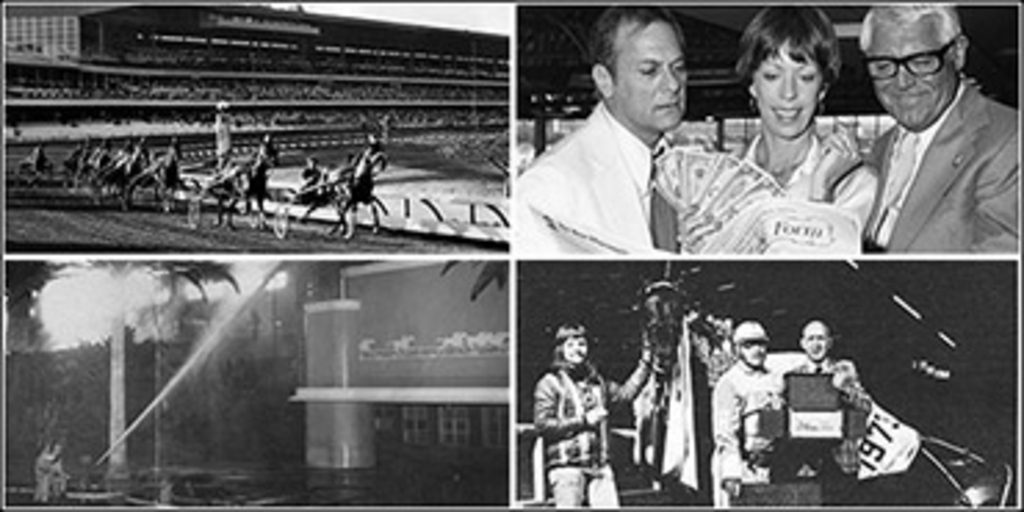
 In this week's Rewind Robert Smith recalls the glory days of harness racing in California. For many years the annual racing season closed out with virtually all of the best horses in the land gathering at Hollywood Park.
In this week's Rewind Robert Smith recalls the glory days of harness racing in California. For many years the annual racing season closed out with virtually all of the best horses in the land gathering at Hollywood Park.
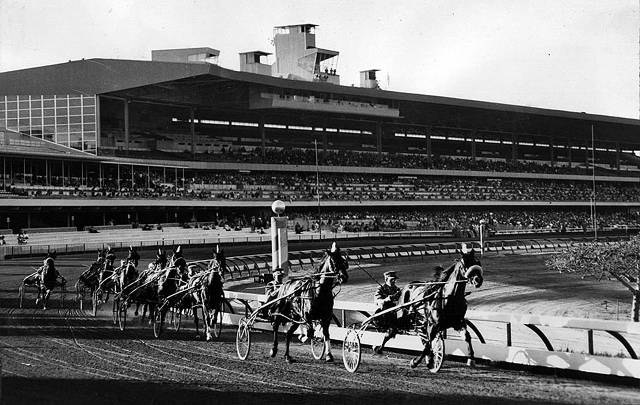
This 1957 photo shows a field of horses in the early stages of a race at Hollywood Park. In the background is the huge grandstand and other facilities at this famous track. [Hollywood Park archives]
Over the years many Canadian horses and horse people competed in those once famous fall meetings in the Golden State. Long before the days of The Breeders Crown, many of the season's champions and even heated rivalries were decided at Hollywood Park located in Inglewood, Cal. The fall session usually began around October 1 and lasted a couple of months. The best of the best assembled there and great racing ensued. The purses were large, the times were fast and the crowds were often huge.
Hollywood Park was first opened in 1938 and ran for 75 years, although it was closed to racing for a time during WWII when it was used for military purposes. A recent recap of the track's long existence in a Los Angeles Times article stated that "it was built to woo the rich and famous." And so it did throughout much of its existence. Among the original shareholders were movie giants such as Harry Warner of Warner Bros., Sam Goldwin (Metro Goldwyn Mayer) and Mervyn Leroy. Many affluent and high profile personalities were involved in its ownership and also were frequent patrons. Many old photographs show that the track was a drawing card for the 'who's who' from actors like Cary Grant, Jimmy Stewart, Elizabeth Taylor and Michael Jackson. Actor Robert Wagner was a close friend of some of the owners.
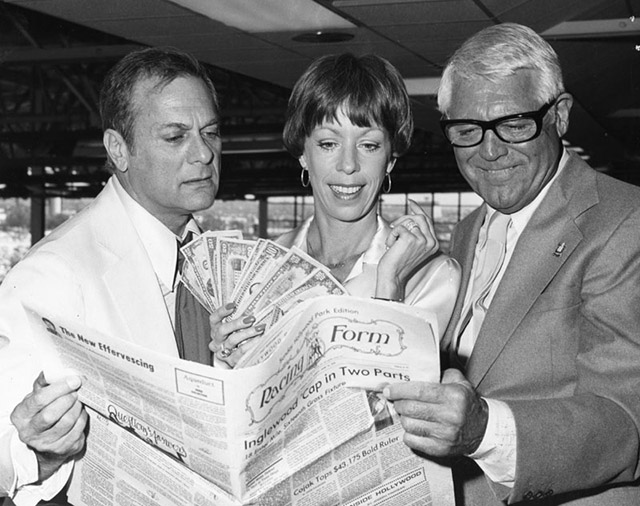
This 1978 photo shows Tony Curtis, Carol Burnett and Cary Grant checking the Racing Form at Hollywood Park.
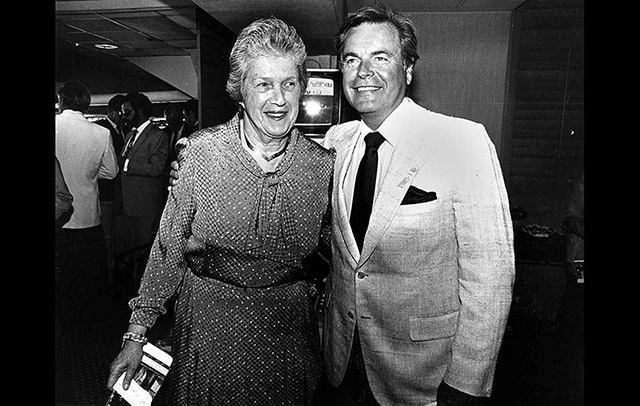
Long time Hollywood Park owner Marje Everett and movie star Robert Wagner chat at the track [Hollywood Park archives]
In a rapid departure from how harness racing was first presented, the posh and grandiose surroundings at places like Hollywood Park changed forever how racing was held. First of all the track was a huge mile in size, and it seemed everything else was a match. In an old write-up, a Raceway patron who had frequented some of the dingier and more austere racing sites once said, "The place was so neat and clean that I had to walk half a mile to spit."
The practice of dining during the races, valet parking, the sale of 'tip' sheets and many other innovative ideas were introduced at this track. On give-away days, gifts were handed out as an enticement to attend the races and most often huge attendances were the result.
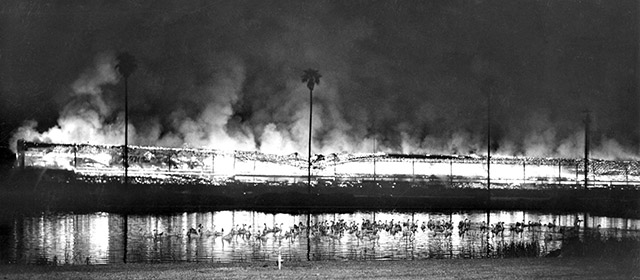
As a 1949 fire ravages the huge Hollywood Park grandstand a huge gathering of geese appear unaffected in their nearby infield lake [LA Times]
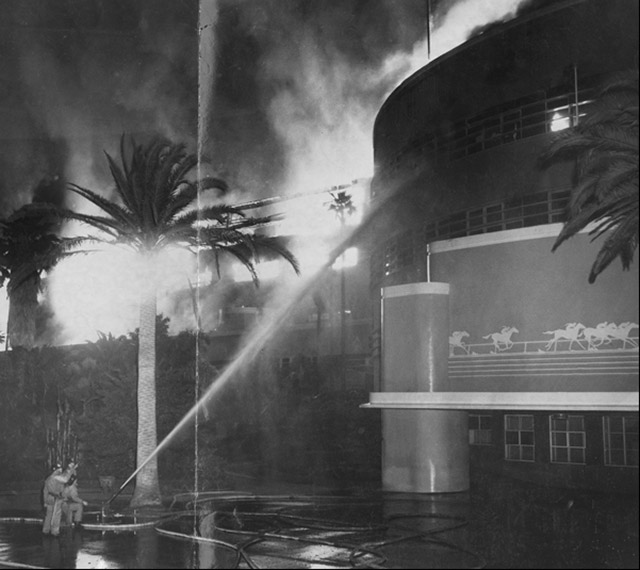
In early May of 1949, a huge fire of unknown origin engulfed the grandstand and clubhouse area of Hollywood Park. It was a spectacular inferno that was billed as perhaps the largest fire ever involving a grandstand. The damage was estimated at $5 million and nearly spelled the end of this famous track. [LA Times]
The next meeting following the fire, Canadian horseman Clint Hodgins led all drivers in wins as he scored 24 wins, 29 seconds and 24 third place finishes in 150 starts. His lofty statistics which included stable earnings of $40,000 were accomplished under the strangest of circumstances. This meeting was conducted without a Clubhouse, Turf Club or even a grandstand roof. Reportedly at the end of the meeting even the hardy California fans complained about the fog and smog that hindered their enjoyment of the races.
Bert Madill Heads West in 1957
While he did not make the headlines that year, a small one-horse horseman named Bert Madill then of Strathroy, Ont. made his way across the land and competed at Hollywood Park with his prize mare Carolwyn Grattan. The pair raced throughout the meeting that fall at Hollywood Park and while they did not win a race, they fared well, earning a cheque in nearly every start despite the stiff competition. The trip westward provided Bert with more than a few additions to his already large repertoire of stories.
Elesnar and Percy Robillard Triumph in 1973
In November of 1973, horseman Percy Robillard ventured to Hollywood Park for the very first time. He found the track to his liking and the same was true for his trotter Elesnar, a five-year-old son of Florican owned by Montreal-based George Henderson. Supplemented into both the $50,975 Pacific Trot and the $100,000 American Trotting Classic, this pair won both in convincing fashion. The two races were just a week apart.
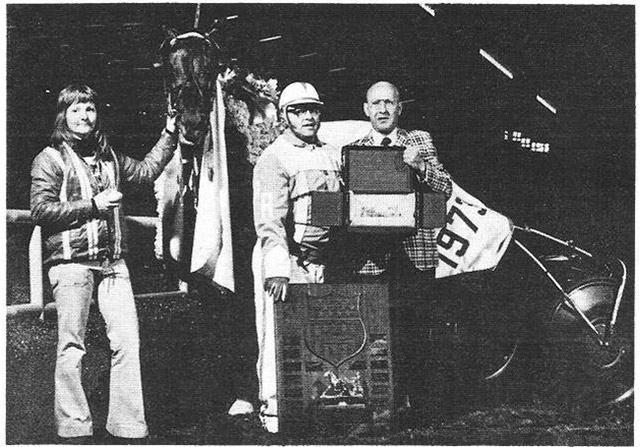
Driver Percy Robillard, well known throughout Canada, makes his first visit to California's Hollywood Park a winning one in 1973. That fall he captured the two biggest trotting events held at Hollywood Park with Elesnar. Making the trophy presentation is noted horseman Delvin Miller as groom Muriel Theriault looks on.
The 1957 American Classics
Over the years, a number of notable Canadian horses and horsemen journeyed to California to test their skills against the best in the business. In 1957 a number of truly great horses contested what was called "The American Classics". These races which were staged weekly, pitted the absolute best horses racing at that time. A series for both aged pacers and trotters was held. Like most racing at the time, the mares had to compete head on with the horses and geldings.
I have listed below some of the horses who competed that year. When the finals were held a purse of $25,000 was up for grabs, a hefty sum in those days. These races attracted the very best horses available during the late fall of each year.
Pacers: Diamond Hal (Joe O'Brien), Dottie's Pick (Del Miller) for Armstrong Bros., Dale Frost, Hundred Proof, Widower Creed, Duane Hanover, Frisco Creed, Ozark Chief. Widower Creed won the final in 1:58.3 for driver Jimmy Wingfield -- the former groom of Greyhound. Dottie's Pick was second.
Trotters: Demon Rum won the consolation for Canadian horseman Cecil Champion. Other big names were Trader Horn, Darn Safe, Lady's First, Jean Laird, Galophone, Bold Rodney, Famous Hanover. Galophone won the final in 2:00.4, driven by Robert Walker.
Night Racing Finally Comes To Hollywood Park
For the first 30 years of its existence Hollywood Park raced only in the afternoons, much like the thoroughbreds. In 1968 after many years of lobbying local and State governments, night harness racing was finally allowed. On the evening of Nov. 12, 1968 a crowd of 14,498 gathered to watch the inaugural race card held under the lights in California. Officials saw it as huge success as only about 7,500 fans were attending during daylight hours. The betting handle on opening night was almost $1.2 million.
One of the major objectors was Jack Kent Cooke, noted sports owner who protested that night racing would reduce the crowds at his neighboring venue where the California Golden Seals played. On the opening night of harness racing the Golden Seals vs. Los Angeles Kings game attracted only 6,009 fans just across the street.
The Final Day
Hollywood Park held its last race program on Sunday December 22, 2013. A huge crowd showed up for the final afternoon of thoroughbred racing. An attendance listed at 13,000 was greatly expanded when a large throng entered the premises after the fourth race when the admission charge was waived. Despite the larger than usual crowd it was a far cry from the days when up to 80,000 people packed the premises. Many of those attending the final day did so for nostalgic purposes, coming back for a final glimpse at a once famous place. Among the crowd were people who recalled the glory days when friends met regularly at the track and loved it. Some had spent their lifetime making attendance at racing's best show part of their regular routine.
As a slight link to the past one of the winning owners and attendees on the final day was Dick Van Patten, 85-year-old actor and one time star of the TV show Eight Is Enough.
In May of this year the last vestige of the great racing site disappeared as a small crowd assembled early on a Sunday morning to watch the grandstand implode. The carefully placed explosives made quick work of the historic structure built in 1950 after the fire. Once home to as many as 2,000 horses during peak racing season, speculators say it may one day soon be home to an NFL team known as The Rams.
Today it seems that the allure that once drew huge crowds to witness live racing is now but a distant memory. The thrill of seeing horses in competition, being part of the excitement and feeling a part of the action is all of another day.

